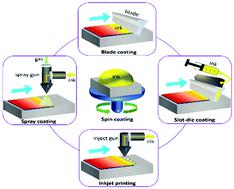当前位置:
X-MOL 学术
›
Energy Environ. Sci.
›
论文详情
Our official English website, www.x-mol.net, welcomes your
feedback! (Note: you will need to create a separate account there.)
Solution-processed perovskite thin-films: the journey from lab- to large-scale solar cells
Energy & Environmental Science ( IF 32.4 ) Pub Date : 2021-08-26 , DOI: 10.1039/d1ee02018h Zahra Saki 1 , Mahdi Malekshahi Byranvand 2, 3 , Nima Taghavinia 1, 4 , Mayank Kedia 2, 3 , Michael Saliba 2, 3
Energy & Environmental Science ( IF 32.4 ) Pub Date : 2021-08-26 , DOI: 10.1039/d1ee02018h Zahra Saki 1 , Mahdi Malekshahi Byranvand 2, 3 , Nima Taghavinia 1, 4 , Mayank Kedia 2, 3 , Michael Saliba 2, 3
Affiliation

|
In the last decade, the power conversion efficiency (PCE) of solution-processed perovskite solar cells (PSCs) in the lab-scale has reached an incredible level of 25.5%. Generally, PSCs are composed of a stack consisting of a perovskite thin-film sandwiched between an electron transporting layer (ETL) and a hole transporting layer (HTL). Although the quality of the ETL and HTL interfaces with the perovskite thin-film is important, the quality of the perovskite thin-film is also critical to achieving high-performance PSCs. Low-temperature deposition of organic–inorganic perovskite thin-films by simple solution processes is one of the significant advantages of PSCs compared to other well-developed semiconductors for manufacturing solar cells. However, growing highly uniform and crystalline solution-processed perovskite thin-films is very challenging due to multiple phenomena during film formation, including solvent evaporation, wetting effects, inhomogeneous film stress and uncontrolled nucleation and growth. Therefore, understanding the different stages of perovskite crystallization is critical for achieving high-quality films and realizing higher PCEs. On the other hand, switching to large-scale solar modules leads to a substantial loss in performance, decreasing the chance of commercialization of this technology. Therefore, developing large-scale deposition techniques for reliable perovskite crystallization is very vital for scaling up PSCs. So far, several solution-processed methods such as anti-solvent and two-step processes have been developed for lab-scale perovskite thin-films deposition. However, these methods are not applicable for large-scale perovskite deposition. This review explores various scalable solution-processed perovskite deposition techniques. Moreover, different solvent quenching techniques as the most critical step of large-scale perovskite crystallization are discussed to provide a comprehensive view for achieving high-quality perovskite thin-films with large areas. Finally, the existing challenges and opportunities to push forward the commercialization of PSCs are discussed.
中文翻译:

溶液处理的钙钛矿薄膜:从实验室到大规模太阳能电池的旅程
在过去十年中,实验室规模的溶液处理钙钛矿太阳能电池 (PSC) 的功率转换效率 (PCE) 已达到令人难以置信的 25.5% 水平。通常,PSC 由夹在电子传输层 (ETL) 和空穴传输层 (HTL) 之间的钙钛矿薄膜组成的堆叠组成。尽管 ETL 和 HTL 与钙钛矿薄膜的界面质量很重要,但钙钛矿薄膜的质量对于实现高性能 PSC 也至关重要。与用于制造太阳能电池的其他成熟半导体相比,通过简单的溶液工艺低温沉积有机-无机钙钛矿薄膜是 PSC 的显着优势之一。然而,由于薄膜形成过程中的多种现象,包括溶剂蒸发、润湿效应、不均匀的薄膜应力以及不受控制的成核和生长,因此生长高度均匀和结晶的溶液处理钙钛矿薄膜非常具有挑战性。因此,了解钙钛矿结晶的不同阶段对于获得高质量的薄膜和实现更高的 PCE 至关重要。另一方面,改用大型太阳能模块会导致性能大幅下降,降低了该技术商业化的机会。因此,开发用于可靠钙钛矿结晶的大规模沉积技术对于扩大 PSC 至关重要。迄今为止,已经开发了几种溶液处理方法,例如反溶剂和两步法,用于实验室规模的钙钛矿薄膜沉积。然而,这些方法不适用于大规模钙钛矿沉积。本综述探讨了各种可扩展的溶液处理钙钛矿沉积技术。此外,还讨论了作为大规模钙钛矿结晶最关键步骤的不同溶剂淬火技术,为实现大面积高质量钙钛矿薄膜提供了全面的视角。最后,讨论了推动 PSC 商业化的现有挑战和机遇。讨论了作为大规模钙钛矿结晶最关键步骤的不同溶剂淬火技术,为实现大面积的高质量钙钛矿薄膜提供全面的视角。最后,讨论了推动 PSC 商业化的现有挑战和机遇。讨论了作为大规模钙钛矿结晶最关键步骤的不同溶剂淬火技术,为实现大面积的高质量钙钛矿薄膜提供全面的视角。最后,讨论了推动 PSC 商业化的现有挑战和机遇。
更新日期:2021-09-28
中文翻译:

溶液处理的钙钛矿薄膜:从实验室到大规模太阳能电池的旅程
在过去十年中,实验室规模的溶液处理钙钛矿太阳能电池 (PSC) 的功率转换效率 (PCE) 已达到令人难以置信的 25.5% 水平。通常,PSC 由夹在电子传输层 (ETL) 和空穴传输层 (HTL) 之间的钙钛矿薄膜组成的堆叠组成。尽管 ETL 和 HTL 与钙钛矿薄膜的界面质量很重要,但钙钛矿薄膜的质量对于实现高性能 PSC 也至关重要。与用于制造太阳能电池的其他成熟半导体相比,通过简单的溶液工艺低温沉积有机-无机钙钛矿薄膜是 PSC 的显着优势之一。然而,由于薄膜形成过程中的多种现象,包括溶剂蒸发、润湿效应、不均匀的薄膜应力以及不受控制的成核和生长,因此生长高度均匀和结晶的溶液处理钙钛矿薄膜非常具有挑战性。因此,了解钙钛矿结晶的不同阶段对于获得高质量的薄膜和实现更高的 PCE 至关重要。另一方面,改用大型太阳能模块会导致性能大幅下降,降低了该技术商业化的机会。因此,开发用于可靠钙钛矿结晶的大规模沉积技术对于扩大 PSC 至关重要。迄今为止,已经开发了几种溶液处理方法,例如反溶剂和两步法,用于实验室规模的钙钛矿薄膜沉积。然而,这些方法不适用于大规模钙钛矿沉积。本综述探讨了各种可扩展的溶液处理钙钛矿沉积技术。此外,还讨论了作为大规模钙钛矿结晶最关键步骤的不同溶剂淬火技术,为实现大面积高质量钙钛矿薄膜提供了全面的视角。最后,讨论了推动 PSC 商业化的现有挑战和机遇。讨论了作为大规模钙钛矿结晶最关键步骤的不同溶剂淬火技术,为实现大面积的高质量钙钛矿薄膜提供全面的视角。最后,讨论了推动 PSC 商业化的现有挑战和机遇。讨论了作为大规模钙钛矿结晶最关键步骤的不同溶剂淬火技术,为实现大面积的高质量钙钛矿薄膜提供全面的视角。最后,讨论了推动 PSC 商业化的现有挑战和机遇。











































 京公网安备 11010802027423号
京公网安备 11010802027423号